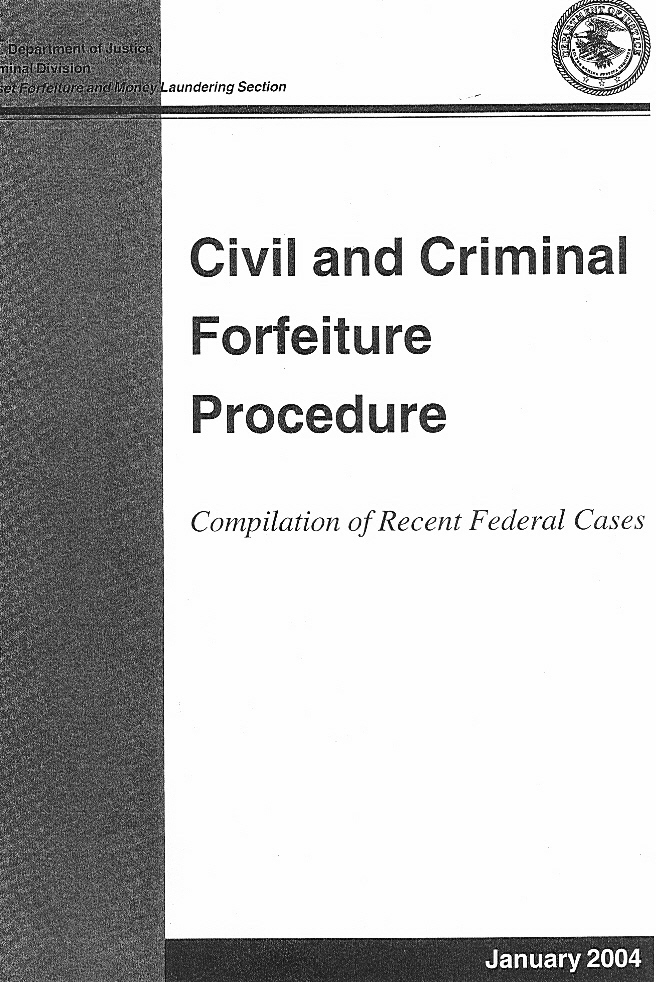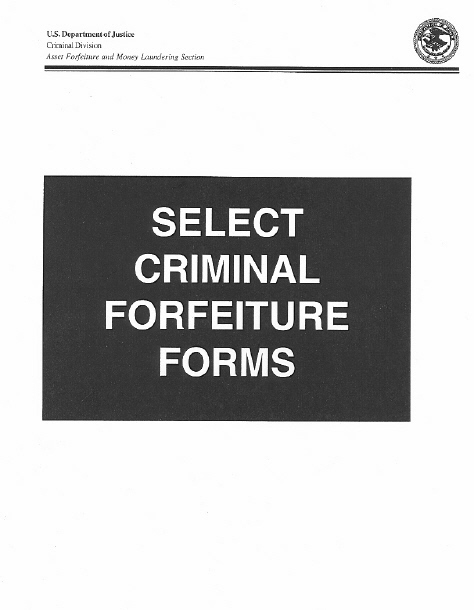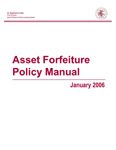FEAR resources for defense attorneys
updated 10/7/2017
Before Evel Knievel jumped a motorcycle over 9 cars or the Grand Canyon, the t.v. announcer always said "Don't try this at home!" Often we wish we could give attorneys a similar warning when they take on their first forfeiture case. Forfeiture procedure is full of traps for the unwary. Although it involves both civil and criminal procedure, it doesn't follow either of them all the time, and there are quirky rules for in rem procedure that most lawyers never encounter in other cases.
When a client's property is first seized you won't know whether it will be prosecuted as a state or federal case, or as a criminal or civil forfeiture. Even if you know who seized the property or who is prosecuting the related criminal case, the forfeiture case is often prosecuted by a different entity. Once the process starts moving, it moves rapidly, with a series of deadlines and choices you have to make at each turn. You can really mess up a case if you miss one of the early deadlines or make a mistake, like choosing the petition for remission option (and thereby waiving judicial remedies), or forgetting to demand a jury trial in the answer.
We want to make sure you don't "try this at home" without the proper knowledge and equipment.
Here's the equipment we recommend for any attorney's first-time encounter with asset forfeiture:
(1) read "What to Do When Your Property Has Been Seized", to get an overview of the forfeiture processes. (The information from that webpage is also available as a FEAR pamphlet which you can print out on-line in PDF form and give to your clients). An expanded version of that document, with additional answers to frequently asked questions and an appendix of key statutes, is available as an ebook for $5.99.
(2) if your case is being prosecuted as a state forfeiture, get the state statutes from FEAR's Law Library
(3) if your case is being prosecuted under federal law, look up the federal statute(s) in the FEAR Law Library
(4) buy FEAR's Asset Forfeiture Defense Manual - especially if your case is federal. You'll need it. It will pay for itself the first hour you use it. Even in state forfeiture cases, the manual provides valuable background information, constitutional principles and case law that is generally applicable to state cases. State procedures were usually modeled after the federal procedures, although state procedures now vary from state to state. If you need to expedite your order, call FEAR after placing your order and give us your Fed Ex account number and we'll overnight the book to you.
(5) subscribe to FEAR's online Brief Bank II & Private Collection. It only costs $100 a year, and the sample pleadings, motions, discovery requests and briefs are worth many thousands of dollars worth of your time - and may well prevent you from making a big mistake.
(6) purchase Forfeiture 101 - FEAR's Continuing Legal Education DVD course that enables defense attorneys to effectively expand their practices to meet the needs of the vastly increasing number of victims of the government's ever-broadening overreach for assets and money judgments. Lawyers taking on their first forfeiture case suddenly find that law school never prepared them for the maze of complex proceedings that strictly adhere to Supplemental Rules for Admiralty or Maritime Claims and Asset Forfeiture Actions, further complicated by CAFRA reforms that apply to some forfeiture proceedings and not to others. Forfeiture victims will find this DVD to be a godsend – especially those forced to represent themselves because they can't afford counsel.
Experienced forfeiture defense attorneys:
(1) FEAR's Asset Forfeiture Defense Manual is now out of stock and out of print. Please use the FEAR website Law Library to research your federal forfeiture issues.
(2) two DOJ publications we recommend for your desktop library are available for free in PDF format from the FEAR website. Print them out online at the following links:
- DOJ publication "Civil Asset Forfeiture Reform Act of 2000" (file name: DOJ_CAFRA) - contains the provisions of U.S. Code which were amended or added by CAFRA, with strikeouts indicating previous language. This is very useful when you're trying to decide whether a pre-CAFRA case interpreting statutory procedure is good law or not
- DOJ publication "Selected Asset Forfeiture Statutes" (file names: DOJ_Select_) - [DOJ_SelectPt1] [DOJ_SelectPt2] [DOJ_SelectPt3]
|
|
(3) subscribe to FEAR's online Brief Bank II & Private Collection- a huge time saver whenever you need a new sample pleading, motion, etc. Then send us your best briefs, pleadings, motions and discovery requests to contribute to our collection. Currently we have over 160 motions, pleadings and briefs in Brief Bank II, with more being added all the time. A subscription membership to FEAR's Brief Bank also includes access to our Private Collection of documents, including several Department of Justice manuals on asset forfeiture law, statutes and policy.
(4) take advantage of FEAR's online Forfeiture Lawyer Directory. You can sign up by filling out this form.
(5) print out FEAR's tri-fold pamphlet "What to Do If Your Property Has Been Seized", make copies and keep them in your reception room for clients to read and take home, to answer their frequently asked questions.
(6) sign up for FEAR-List, a free email bulletin service for forfeiture news and updates on changes in forfeiture law.
(7) take advantage of the FEAR website as a research tool. The FEAR on-line Law Library has links to on-line state statutes and most of the federal statutes pertaining to forfeiture (we've updated our collection recently, but we're still not sure we've included all the criminal statutes incorporated by reference as forfeiture triggers in the past 4 years.) If you find a statute we haven't included, let us know.
FEAR pamphlet available for download -- What to Do When Your Property Has Been Seized
FEAR's classic trifold pamphlet "What to Do When Your Property Has Been Seized" is now a web page with links to other important self-help materials. This updated tri-fold pamphlet is also available in PDF format, by Brenda Grantland, Esq. (2004) (a brief, simple overview of the civil forfeiture process which answers the questions forfeiture victims most frequently ask).
*******************************************************************************
|
FEAR's updated, expanded, revamped and improved
Attorneys: Please send us your best forfeiture briefs and motions, so that we can expand our collection.  The DOJ's Civil and Criminal Forfeiture Procedure - 300+ pages [All parts available in PDF format; Parts I and III available in hypertext (web pages); rest is coming soon] The DOJ's Civil and Criminal Forfeiture Procedure - 300+ pages [All parts available in PDF format; Parts I and III available in hypertext (web pages); rest is coming soon]"...Of the five DOJ publications on forfeiture which the government ordered public libraries to destroy last summer (and then retracted its order because of our public outcry) , this almost-suppressed publication is the most important to forfeiture victims and defense lawyers. It contains the Justice Department's official position on the key legal issues the defense commonly encounters in civil and criminal forfeiture cases, and is updated with the changes made by CAFRA (the Civil Asset Forfeiture Reform Act of 2000). "This DOJ publication is a good way to start your research..."  The DOJ's Select Criminal Forfeiture Forms - [26 page introduction available in hypertext and PDF format] The DOJ's Select Criminal Forfeiture Forms - [26 page introduction available in hypertext and PDF format]"This almost-banned Department of Justice publication contains some statements about criminal forfeiture procedure which could be very useful to forfeiture victims. I used a quote from the introduction, "Criminal Forfeiture Procedure," to great effect in countering a prosecutor's argument that certain provisions of civil forfeiture law did not apply to a seizure of some airplanes because (he said) they were seized with a criminal forfeiture warrant.... "...nothing I could cite would have had the impact of quoting the Department of Justice's own manuals on the subject."  ** The DOJ's Asset Forfeiture Policy Manual, published in January 2006, is a treasure trove of information. ** The DOJ's Asset Forfeiture Policy Manual, published in January 2006, is a treasure trove of information. Forfeiture-savvy journalists will have a field day with this! Defense lawyers will love it too.
Although the U.S. Supreme Court held in United States v. Caceres, 440 U.S. 741 (1979) that the government's "official policies" are not enforceable in court in suits brought by private parties, the government's policies are valuable to defense lawyers and pro se litigants, enabling them to make intelligent decisions in settlement discussions and other matters. Also, when the forfeiture prosecutor takes an unreasonable stance in court or in negotiations, it certainly helps to quote the official policy manuals of the DOJ! FEAR's On-Line Forfeiture Lawyer Directory Forfeiture lawyers can have their credentials, and even a photo, posted in FEAR's website Lawyer Directory for $100 per year. Just fill out the Attorney Application on line, and send your photograph (optional) to F.E.A.R., 669 Northern Avenue, Mill Valley, CA 94941. You can also send your digital photo as an email attachment by e-mailing Brenda. Note: we only accept attorneys who have prior experience handling forfeiture cases. The FEAR on-line Law Library provides links to on-line state statutes and most of the federal statutes pertaining to forfeiture (we've updated our collection recently, but we're still not sure we've included all the criminal statutes incorporated by reference as forfeiture triggers in the past 4 years.) If you find a statute we haven't included, let us know. Other resources: The official annual reports for the federal Forfeiture Funds are online. For the Department of Justice's fund see DOJ's website Reports to Congress. The Treasury Department's reports are online at http://www.treas.gov/offices/enforcement/teoaf/annual-reports.shtml .
The U. S. Attorneys' Manual , complete with a search function, is online. The area of most interest to us is Section 9-111, "FORFEITURE/SEIZURE". Manuals and law review articles by Stefan D. Cassella, Deputy Chief, Asset Forfeiture and Money Laundering Section, U.S. Department of Justice:
Asset Forfeiture Law in the United States, collects in one place all of the law on administrative, civil and criminal forfeiture procedure - including the changes made in 2006. This handy one volume treatise serves as resource to anyone needing a comprehensive discussion of any of the recurring and evolving forfeiture issues that arise daily in federal practice. Asset forfeiture has become a routine part of federal criminal law enforcement. The federal law enforcement agencies, including the DEA, the FBI, and the agencies of the Department of Homeland Security, initiate tens of thousands of administrative forfeiture cases every year, and federal prosecutors file civil and criminal forfeiture actions in federal courts in thousands of cases as well. Overall, in each of the last few fiscal years, the Government has confiscated over three-quarters of a billion dollars in criminally-derived property. This law enforcement activity has naturally generated a deluge of case law from the federal courts. New forfeiture cases are decided every week, making it difficult for the courts themselves, as well as practitioners, to keep current. Moreover, Congress is constantly amending the forfeiture laws and enacting new ones – including a set of new forfeiture provisions included in the USA Patriot Improvement and Reauthorization Act signed by the President in March 2006. Finally, in response to the explosion in forfeiture litigation, the Supreme Court has issued a new Supplemental Rule G of the Federal Rules of Civil Procedure dealing exclusively with civil forfeiture that took effect on December 1, 2006. Table of Contents here.
|